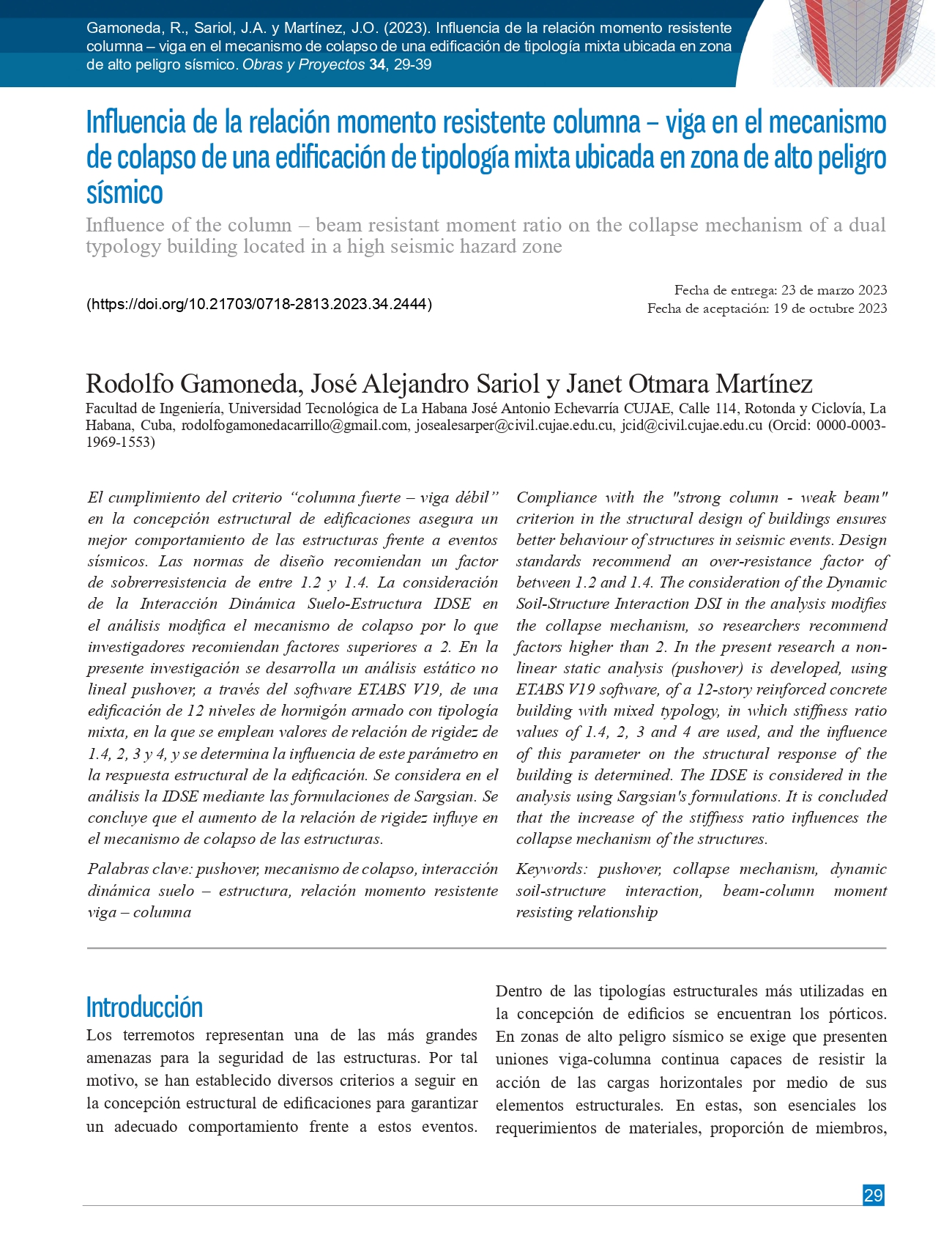Influencia de la relación momento resistente columna – viga en el mecanismo de colapso de una edificación de tipología mixta ubicada en zona de alto peligro sísmico
DOI:
https://doi.org/10.21703/0718-2813.2023.34.2444Palabras clave:
Pushover, Mecanismo de colapso, Interacción dinámica suelo – estructura, Relación momento resistente viga – columnaResumen
El cumplimiento del criterio “columna fuerte – viga débil” en la concepción estructural de edificaciones asegura un mejor comportamiento de las estructuras frente a eventos sísmicos. Las normas de diseño recomiendan un factor de sobrerresistencia de entre 1.2 y 1.4. La consideración de la Interacción Dinámica Suelo-Estructura IDSE en el análisis modifica el mecanismo de colapso por lo que investigadores recomiendan factores superiores a 2. En la presente investigación se desarrolla un análisis estático no lineal pushover, a través del software ETABS V19, de una edificación de 12 niveles de hormigón armado con tipología mixta, en la que se emplean valores de relación de rigidez de 1.4, 2, 3 y 4, y se determina la influencia de este parámetro en la respuesta estructural de la edificación. Se considera en el análisis la IDSE mediante las formulaciones de Sargsian. Se concluye que el aumento de la relación de rigidez influye en el mecanismo de colapso de las estructuras.
Referencias
ACI-318 (2019). Building code reqirements for structural concrete. American Concrete Institute, Farmington Hills, USA.
BSL (2013). Introduction to the building standard law - Building Regulation in Japan. Tokyo, Japan.
Carobeno, C.; Pereira, E.; Andrade, R.; Rodrigues, I., Siqueira, G. (2022). Strong column-weak beam: impacto do uso de relações de momento resistente pilar-viga na localização e formação de rótulas plásticas em estruturas de concreto armado. 63° Congresso Brasileiro do Concreto, Brasilia, Brasil.
Corredor, L.O. (2018). Diseño de una estructura de hormigón con pórticos resistentes a momento según NEC-15. Trabajo de título de Ingeniero Civil, Universidad San Francisco de Quito, Ecuador.
CSI (2019). Structural software for building analysis and design. ETABS v19. Computers & Structures Inc. CSI, Walnut Creek CA, USA.
E.060 (2020). Concreto armado. Ministerio de Vivienda, Construcción y Saneamiento, Perú.
EC-8 (2009). Design of structures for earthquake resistance - Part 1 : General rules, seismic actions and rules for buildings. The European Standard, Brussels, Belgium.
EHE-08 (2010). Instrucción de hormigón estructural. Ministerio de Fomento, España.
FEMA 440 (2005). Improvement of nonlinear static seismic analysis procedures. Federal Emergency Management Agency FEMA, Washington DC, USA.
IS-456 (2000). Plain and reinforced concrete - code of practice. Bureau of Indian Standards, New Delhi, India.
Mejía, R.J. (2017). Estudio sobre la efectividad del criterio pilar fuerte-viga débil en el diseño sísmico de pórticos de hormigón. Tesis de master, Universitat Politècnica de Catalunya, Barcelona,España.
Meli Piralla, R. (2002). Diseño estructural. Segunda edición. Limusa, México.
Montoya, L.A. (2016). A direct performance based seismic design method for irregular structures: applications to concrete structures. Doctorate thesis, Universidad Politécnica de Catalunya, Barcelona, España.
NC-207 (2019). Requisitos generales para el diseño y construcción de estructuras de hormigón. Oficina Nacional de Normalización, La Habana, Cuba.
NC-283 (2003). Densidad de materiales naturales, artificiales y de elementos de construcción como carga de diseño. Oficina Nacional de Normalización, La Habana, Cuba.
NC-284 (2003). Edificaciones. Cargas de uso. Oficina Nacional de Normalización, La Habana, Cuba.
NC-450 (2006). Edificaciones-factores de carga o ponderación combinaciones. Oficina Nacional de Normalización, La Habana, Cuba.
NC-46 (2017). Construcciones sismorresistentes. Requisitos básicos para el diseño y construcción. Oficina Nacional de Normalización, La Habana, Cuba.
NCh430 (2008). Hormigón armado - Requisitos de diseño y cálculo. INN, Santiago, Chile.
NEC-SE-HM (2015). Estructuras de hormigón armado. Ministerio de Desarrollo Urbano y Vivienda. Norma Ecuatoriana de la Construcción, Ecuador.
Nie, X., Zhang, S., Jiang, T. and Yu, T. (2020). The strong column – weak beam design philosophy in reinforced concrete frame structures : A literature review. Advances in Structural Enginnering 23(16), 3566–3591.
NTC (2008). Norme tecniche per le costruzioni. Gazzetta Ufficiale della Repubblica italiana, Italia.
NZS-3103 (2006). The design of concrete structures. Standards New Zealand, Wellington, New Zealand.
NZS-3101 (1995). Design of concrete structures. Standards New Zealand, Wellington, New Zealand.
Pereira, E.M.V. (2021). Estudo da fragilidade sísmica de pórticos de concreto armado com irregularidades estruturais. Tesis de master, Universidade Estadual de Campinas, Brasil.
Quintana-Gallo, P. (2019). Seismic shear demands in columns of RC frames accounting for dynamic amplification effects. Obras y Proyectos 26, 87-99.
Surana, M., Singh, Y. and Lang, D.H. (2018). Effect of strong ‑ column weak ‑ beam design provision on the seismic fragility of RC frame buildings. International Journal of Advanced Structural Engineering 10(2), 131–141.
Villarreal, G. (2017). Interacción sísmica suelo-estructura en edificaciones con plateas de cimentación. Editora & Imprenta Gráfica Norte S.R.L., Trujillo, Perú.

Descargas
Publicado
Número
Sección
Licencia

Esta obra está bajo una licencia internacional Creative Commons Atribución-NoComercial 4.0.







